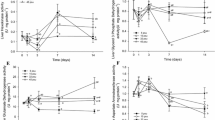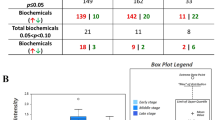Abstract
Invertebrates change the metabolite concentrations in their bodies to adapt to environmental salinity. The kuruma shrimp Marsupenaeus japonicus is one such invertebrate. It lives in coastal areas and is also known to change free amino acid concentrations depending on environmental salinity. To examine the relationship between the concentrations of metabolites, including amino acids, in the kuruma shrimp with environmental salinity, metabolome analysis was performed on the abdominal muscle of shrimps acclimated at 17, 34 and 40‰ salinity for 24 h. Principal component analysis revealed that the accumulation patterns of metabolites using the 111 metabolites detected in the shrimps exposed to different salinities were depicted in a salinity-dependent manner. The concentrations of alanine and glutamine were increased following exposure to increasing levels of salinity, suggesting that these free amino acids function in intracellular osmoregulation of the kuruma shrimp. Furthermore, the concentration of glycolytic metabolites was significantly decreased at high salinity. The concentrations of most of the metabolites related to the tricarboxylic acid (TCA) cycle also tended to decrease at high salinity. Considering the levels of expression of the genes related to various metabolic pathways, it seems that glycolysis is accelerated at high salinity.









Similar content being viewed by others
References
Abe H, Okuma E, Amano H, Noda H, Watanabe K (1999a) Role of free d- and l-alanine in the Japanese mitten crab Eriocheir japonicus to intracellular osmoregulation during downstream spawning migration. Comp Biochem Physiol 123A:55–59
Abe H, Okuma E, Amano H, Noda H, Watanabe K (1999b) Role of free d- and l-amino acids in the muscle of crayfish during seawater acclimation. Comp Biochem Physiol 109A:191–197
Abe H, Yoshikawa N, Sarower MG, Okada S (2005) Distribution, metabolism, and physiological function of free d-amino acids in invertebrates. Vitamin Soc Japan 79:79–86
Boudour-Boucheker N, Boulo V, Charmantier-Daures M, Grousset E, Anger K, Charmantier G, Lorin-Nebel C (2014) Differential distribution of V-type H+-ATPase and Na+/K+-ATPase in the branchial chamber of the palaemonid shrimp Macrobrachium amazonicum. Cell Tissue Res 357:195–206
Camien MN, Sarlet H, Duchâteau G, Florkin M (1951) Non-protein amino acids in muscle and blood of marine and fresh water crustacea. J Biol Chem 193:881–885
Deaton LE (2001) Hyperosmotic volume regulation in the gills of the ribbed mussel, Geukensia demissa: rapid accumulation of betaine and alanine. J Exp Mar Biol Ecol 260:185–197
Delgado-Gaytán MF, Gómez-Jiménez S, Gámez-Alejo LA, Rosas-Rodríguez JA, Figueroa-Sato CG, Valenzuela-Sato EM (2020) Effect of salinity on the synthesis and concentration of glycine betaine in osmoregulatory tissues from juvenile shrimps Litopenaeus vannamei. Comp Biochem Physiol 240A:110628
Faleiros RO, Goldman MHS, Furriel RPM, McNamara JC (2010) Differential adjustment in gill Na+/K+- and V-ATPase activities and transporter mRNA expression during osmoregulatory acclimation in the cinnamon shrimp Macrobrachium amazonicum (Decapoda, Palaemonidae). J Exp Biol 213:3894–3905
Freire CA, Onken H, McNamara JC (2008) A structure-function analysis of ion transport in crustacean gills and excretory organs. Comp Biochem Physiol 151A:272–304
Fujimori T, Abe H (2002) Physiological roles of free d- and l-alanine in the crayfish Procambarus clarkii with special reference to osmotic and anoxic stress responses. Comp Biochem Physiol 131A:893–900
Gainey LF, Greenberg MJ (1977) Physiological basis of the species abundance-salinity relationship in Molluscs: a speculation. Mar Biol 40:41–49
Gao W, Tan B, Mai K, Chi S, Liu H, Dong X, Yang Q (2012) Profiling of differentially expressed genes in hepatopancreas of white shrimp (Litopenaeus vannamei) exposed to long-term low salinity stress. Aquaculture 364–365:186–191
Gaucher C, Boudier A, Bonetti J, Clarot I, Leroy P, Parent M (2018) Glutathione: antioxidant properties dedicated to nanotechnologies. Antioxidants 7:62
Havird JC, Santos SR, Henry RP (2014) Osmoregulation in the Hawaiian anchialine shrimp Halocaridina rubra (Crustacea: Atyidae): expression of ion transporters, mitochondria-rich cell proliferation and hemolymph osmolality during salinity transfers. J Exp Biol 217:2309–2320
Henry RP, Mangum CP, Webb KL (1980) Salt and water balance in the oligohaline clam, Rangia cuneata. II. Accumulation of intracellular free amino acids during high salinity adaptation. J Exp Zool 211:11–24
Holliday CW (1985) Salinity induced changes in gill Na, K-ATPase activity in the mud fiddler crab, Uca pugnax. J Exp Zool 233:199–208
Ihaka R, Gentleman R (1996) R: a language for data analysis and graphics. J Comput Graph Stat 5:299–314
Jaisson S, Pietrement C, Gillery P (2011) Carbamylation-derived products: bioactive compounds and potential biomarkers in chronic renal failure and atherosclerosis. Clin Chem 57:1499–1505
Koyama H, Okamoto S, Watanabe N, Hoshino N, Jimbo M, Yosumoto K, Watabe S (2015) Dynamic changes in the accumulation of metabolites in brackish water clam Corbicula japonica associated with alternation of salinity. Comp Biochem Physiol 181B:59–70
Koyama H, Mizusawa N, Hoashi M, Tan E, Yasumoto K, Jimbo M, Ikeda D, Yokoyama T, Asakawa S, Piyapattanakorn S, Watabe S (2018) Changes in free amino acid concentrations and associated gene expression profiles in the abdominal muscle of kuruma shrimp (Marsupenaeus japonicus) acclimated at different salinities. J Exp Biol 221:jeb168997
Li J, Peng M, Liu P, Chen P, Li J (2015) The roles of Na+/K+-ATPase α-subunit gene from the ridgetail white prawn Exopalaemon carinicauda in response to salinity stresses. Fish Shellfish Immunol 42:264–271
McNamana JC, Rosa JC, Greene LJ, Augusto A (2004) Free amino acid pools as effectors of osmotic adjustment in different tissues of the freshwater shrimp Macrobrachium olfersii (Crustacea, Decapoda) during long-term salinity acculimation. Mar Freshw Behav Physiol 37:193–208
Neshich IAP, Kiyota E, Arruda P (2013) Genome-wide analysis of lysine catabolism in bacteria reveals new connections with osmotic stress resistance. ISME J 7:2400–2410
Okuma E, Abe H (1994) Total d-amino and other amino acids increase in the muscle of crayfish during seawater acclimation. Comp Biochem Physiol 109A:191–197
Pérez-García F, Brito L F, Wendisch V F (2019) Function of L-pipecolic acid as compatible solute in Corynebacterium glutamicum as basis for its production under hyperosmolar conditions. Front Microbiol 10: Article 340
Ramaglia AC, de Castro LM, Augusto A (2018) Effect of ocean acidification and salinity variations on the physiology of osmoregulating and osmoconforming crustaceans. J Comp Physiol 188B:729–738
Romano N, Zeng C (2012) Osmoreguration in decapod crustaceans: implications to aquaculture productivity, methods for potential improvement and interactions with elevated ammonia exposure. Aquaculture 334–337:12–23
Shekhar MS, Kiruthika J, Ponniah AG (2013) Identification and expression analysis of differentially expressed genes from shrimp (Penaeus monodon) in response to low salinity stress. Fish Shellfish Immunol 35:1957–1968
Shekhar MS, Kiruthika J, Rajesh S, Ponniah AG (2014) High salinity induced expression profiling of differentially expressed genes in shrimp (Penaeus monodon). Mol Biol Rep 41:6275–6289
Soga T, Baran R, Suematsu M, Ueno Y, Ikeda S, Sakurakawa T, Kakazu Y, Ishikawa T, Robert M, Nishioka T, Tomita M (2006) Differential metabolomics reveals ophthalmic acid as an oxidative stress biomarker indicating hepatic glutathione consumption. J Biol Chem 281:16768–16776
Steer ML (1976) Cyclic AMP. Ann Surg 184:107–115
Sun H, Zhang L, Ren C, Chen C, Fan S, Xia JJ, Lin H, Hu C (2011) The expression of Na, K-ATPase in Litopenaeus vannamei under salinity stress. Mar Biol Res 7:623–628
Vilas C, Drake P, Pascual E (2006) Oxygen consumption and osmoregulatory capacity in Neomysis integer reduce competition for resources among mysid shrimp in a temperate estuary. Physiol Biochem Zool 79:866–877
Yamamoto H, Fujimori T, Sato H, Ishikawa G, Kami K, Ohashi Y (2014) Statistical hypothesis testing of factor loading in principal component analysis and its application to metabolite set enrichment analysis. BMC Bioinformatics 15:51
Yan K, Gao LN, Cui YL, Zhang Y, Zhou X (2016) The cyclic AMP signaling pathway: exploring targets for successful drug discovery (review). Mol Med Rep 13:3715–3723
Acknowledgements
Matsumoto Suisan Co., Ltd., Miyazaki Prefecture, Japan, is greatly acknowledged for their kind supply of live specimens of kuruma shrimp.
Author information
Authors and Affiliations
Corresponding author
Additional information
Publisher's Note
Springer Nature remains neutral with regard to jurisdictional claims in published maps and institutional affiliations.
Rights and permissions
About this article
Cite this article
Koyama, H., Kuniyoshi, H., Piyapattanakorn, S. et al. Changes in metabolite concentrations in the abdominal muscle of the kuruma shrimp Marsupenaeus japonicus in response to different salinities. Fish Sci 87, 383–401 (2021). https://doi.org/10.1007/s12562-021-01512-x
Received:
Accepted:
Published:
Issue Date:
DOI: https://doi.org/10.1007/s12562-021-01512-x




